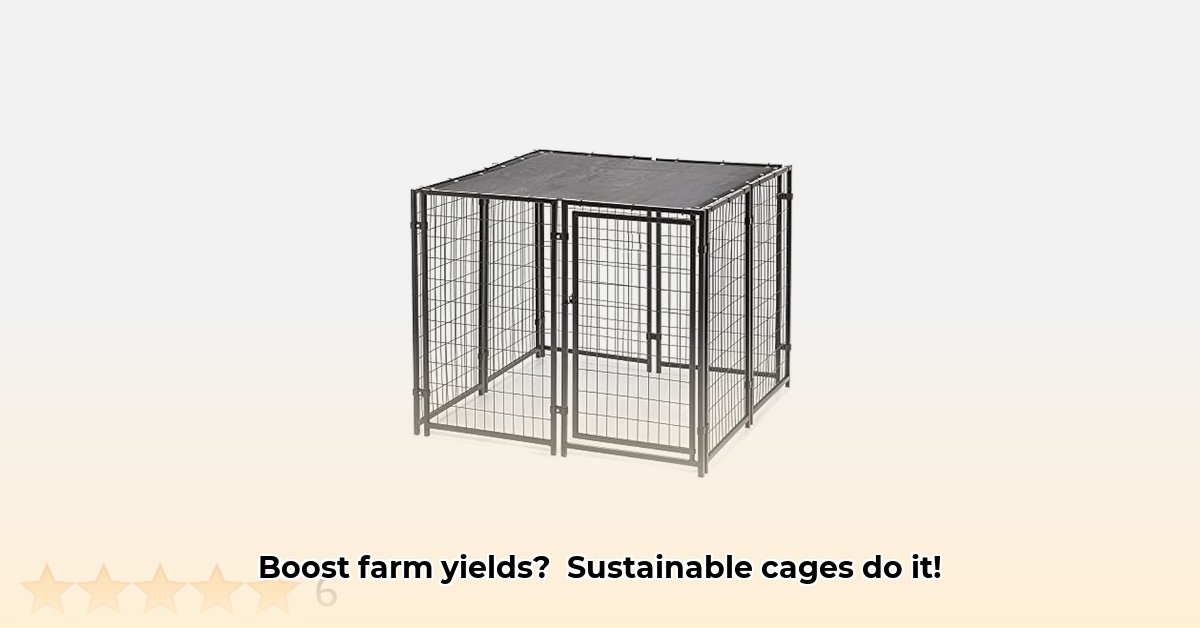
Cage Wire from Tractor Supply: A Sustainable Farming Assessment
Thinking about incorporating Tractor Supply's cage wire into your sustainable farming operation? This comprehensive guide explores the advantages and disadvantages, offering practical guidance for maximizing efficiency and minimizing environmental impact. Choosing the right materials is crucial for ethical and productive agriculture – let's delve into the specifics. For more information on Tractor Supply cage wire, see this detailed guide.
Weighing the Pros and Cons of Tractor Supply Cage Wire
Making informed decisions requires a balanced perspective. Let's examine both the benefits and drawbacks associated with using Tractor Supply's cage wire in your sustainable farming practices.
Advantages:
Cost-Effectiveness: Tractor Supply often offers competitively priced cage wire, making it a practical option, especially for smaller farms or those with tighter budgets. This affordability allows for greater accessibility to necessary infrastructure.
Accessibility and Convenience: The widespread availability of Tractor Supply stores simplifies procurement, eliminating lengthy supply chain delays. Farmers can readily obtain the materials they need when needed.
Durability (with proper care): Galvanized wire cages, when properly maintained, exhibit considerable longevity, reducing the frequency of replacements and associated costs. This translates to long-term financial savings.
Improved Hygiene: The open design promotes excellent airflow, facilitating easier cleaning and disinfection, thereby minimizing disease transmission among livestock. This contributes to healthier animals and reduced healthcare costs.
Versatility: Tractor Supply provides a range of wire gauges and configurations, enabling farmers to select options tailored to the specific needs of different animal species and sizes. This flexibility adapts to diverse farming contexts.
Disadvantages:
Animal Welfare Concerns: The potential for discomfort is a valid concern. Wire mesh can be abrasive, potentially causing foot injuries. Providing adequate bedding and appropriate flooring mitigates this risk. It's crucial to assess the specific needs of each species.
Environmental Impact: Production and disposal of the wire contribute to the overall environmental footprint. The manufacturing process consumes resources and energy; responsible disposal practices are essential for minimizing any negative consequences.
Maintenance Requirements: Regular inspections for damage, rust, and timely repairs are necessary to extend the lifespan of the cages. Neglecting maintenance can lead to premature failure and increased waste.
Limited Applicability: Wire cages are not universally suitable. Free-range or pasture-raised livestock require alternative housing systems. The suitability must be assessed based on species and farming practices.
Optimizing Tractor Supply Cage Wire for Sustainable Farming
Using cage wire effectively within a sustainable farming framework requires a strategic approach. Consider these steps:
Species-Specific Needs Assessment: Prioritize thorough research into the specific requirements of your livestock. Consider size, weight, behavioral needs, and any susceptibility to injury from wire mesh. This influences choosing the appropriate wire gauge and cage dimensions.
Strategic Cage Design and Placement: Avoid overcrowding; ensure ample space per animal. Optimal cage placement considers sunlight exposure, shade provision, wind protection, and overall environmental comfort.
Rigorous Hygiene Practices: Regular cleaning and disinfection are paramount to disease prevention. The open design of wire cages facilitates cleaning and reduces pathogen accumulation.
Minimizing Environmental Footprint: Opt for galvanized wire to improve longevity. This reduces the frequency of replacements and the associated environmental impact of manufacturing and disposal. Investigate recycling options for end-of-life cages.
Enrichment Strategies: Consider incorporating environmental enrichment, such as perches or toys, to improve the animals' overall well-being. The suitability and effectiveness depend on the specific species.
Long-Term Sustainability: A Holistic Perspective
Sustainable farming extends beyond individual components; it encompasses the entire farming operation.
Pasture Integration: Cage systems can be effectively combined with rotational grazing or other pasture management strategies to enhance soil health and resource utilization. This optimizes land management practices.
Alternative Exploration: Regularly evaluate long-term housing alternatives to ensure alignment with evolving farming philosophies and animal welfare standards. Staying updated on advancements in sustainable animal housing is crucial.
Choosing Sustainable Wire Cages for Ethical Animal Farming: A Detailed Guide
Key Considerations:
- Consumer demand is driving a shift towards more ethical farming, impacting choices like cage wire selection.
- The term "cage-free" lacks standardization; farmers need to carefully consider what it actually means in practice.
- Economic feasibility and environmental considerations are paramount—planning is key.
- Responsible cage selection minimizes environmental impacts while improving animal welfare.
- The wire gauge and cage design are critical for animal comfort and safety.
Dr. Emily Carter, Professor of Animal Welfare at Cornell University, states: "The ethical use of cage wire necessitates a holistic approach considering both animal welfare and environmental sustainability. Careful planning and species-specific considerations are essential to ensure responsible use."
A Step-by-Step Guide to Sustainable Cage Selection:
- Needs Assessment: Determine the number of animals, species, and available space.
- Supplier Research: Identify reputable suppliers committed to sustainable manufacturing practices.
- Criteria Definition: Establish clear requirements regarding material, wire gauge, cage dimensions, and features.
- Option Comparison: Evaluate different cage designs based on cost-effectiveness and animal welfare considerations.
- Permit Compliance: Verify adherence to all relevant local regulations and animal welfare standards.
- Installation and Monitoring: Install cages correctly and regularly monitor their condition for necessary maintenance or repairs.
Remember, responsible cage selection is an investment in the long-term well-being of your animals and the environmental sustainability of your farm. Careful consideration of these factors ensures a farming operation aligned with ethical and ecological principles.